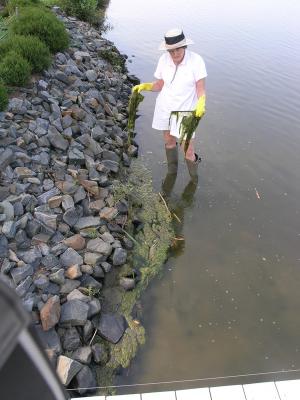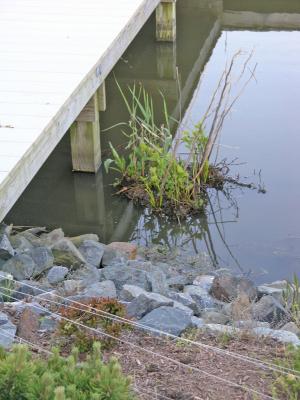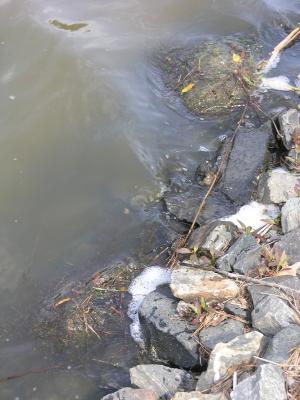State officials and environmental advocates have applauded recent efforts by Rehoboth Beach to stabilize the shorelines at Lake Gerar and Silver Lake. However, as those efforts have take root, some lakefront property owners have not been happy with the results.
For Silver Lake resident Enid Lagree, biologs, used to hold the buffer plantings in place, have not worked as advertised, breaking away due to wave action and higher waters during the winter. She said the high water combined with the waves tore the biologs from the shore with the vegetation in tact.
“They’re supposed to decompose and dissolve. But they don’t do that,” Lagree said.
The biologs also broke apart, and the insides got stuck under Lagree’s dock and all over her riprap, she said.
Lake Gerar resident Kitty Cole said the planted buffer near her house has led to snakes and other animals breeding, making their home in the plants and getting into her basement. She said while the buffer is supposed to be 10 feet wide, it appears to be far wider in other spots. Cole said she misses seeing ducks and geese swimming in the lake; the buffer seems to have stopped the birds from going into the lake, she said.
Regardless, Envirotech President Todd Fritchman stands by the project, which he said has been assessed as a grade-A job by Department of Natural Resources and Environmental Control. He said the project has been doing what it is supposed to be doing and has been reviewed by both state and city officials.
The goals and objectives, Fritchman said, are to keep out nuisance geese, restore water quality, stabilize the shoreline and restore native plants to the area.
Biologs are shoreline stabilization product intended, over time, to create a more natural looking shoreline than riprap and bulkheads. The biologs are made from a biodegradeable fibers bound in netting. Biologs can be made with coir or coconut fibers and are meant to resist wave action until plants and native vegetation planted in and around the biologs can grow.
In 2010, the city undertook a shoreline improvement project at East Lake Drive along Silver Lake, where the lakefront had become badly eroded up to the roadway. To remedy the problem, the city hired Envirotech to install sand and native vegetation to not only extend the shoreline but also create a vegetative buffer, similar to what Envirotech installed at Lake Gerar. One of the ways to accomplish that goal was to use the biologs as a way to spur the growth of native plants and to stabilize the shoreline.
Jim Chaconas, environmental scientist with DNREC, who recently examined the project, said the buffers were tested visually to see how the shoreline is holding up and whether there was any erosion towards the road. He said the plants have taken root and developed, creating a diverse living shoreline at Silver Lake. Chaconas said the project is helping the environment by taking a natural approach that keeps unwanted pests and nuisance plants out of the area.
Lagree said the shoreline vegetation that has sprouted up has not been maintained, leading to a messy and unattractive look. She said the plantings at both Silver Lake and Lake Gerar have become so tall they block the view of the lakes. Many of the nicer plants along the shoreline were planted by people who live in the area, Lagree said.
“It certainly doesn’t look like the pictures on his PowerPoint productions,” she said of Fritchman.
Lagree said biologs have been rejected as a shoreline stabilization technique in Pennsylvania in favor of riprap.
Fritchman said stone and bulkheads do nothing to improve the water quality.
The biologs take three to five years to completely decompose and were put in place to stabilize the shoreline in a natural way, Fritchman said. The fibers of the biologs do break down, he said, but that is an asset to the water colony.
“Everything is functioning perfectly,” Frichman said.
In addition, the project has helped keep nuisance geese out of the lakes, he said. Before the vegetative buffers were put in the roadways near the lakes were full of goose droppings, but now, due to the height of the grass, geese can’t walk into the lakes, Fritchman said.
City Manager Greg Ferrese said the city has a contract with Envirotech to maintain the lakeside vegetation. He said the contract has been in place since the buffers were installed.
Fritchman said the Lake Gerar vegetation is constantly maintained, but the plants at Silver Lake were not maintained until recently because funding was not available. The maintenance process helps keep invasive plants like phragmities out, he said. Ferrese said the cost of maintenance is $9,700 for the Lake Gerar plantings, which wrap around the entire lake, and $2,700 for the smaller Silver Lake buffer.
The projects at Lake Gerar and Silver Lake were spearheaded in part by Save Our Lakes Alliance3, whose board said in a letter, “The improvements at Lake Gerar and Silver Lake may not meet everyone’s aesthetic values, but the intended environmental goals have been accomplished and verified by DNREC with a grade ‘A.’ While there is more to be done to improve our lakes, it is gratifying that all the time and resources put into these projects have produced the intended results.”
SOLA3’s letter said when the Lake Gerar project was undertaken, there were frequent fish kills, odor from geese droppings and pollution into the lake. Since the shoreline buffer was installed, there is abundant fishing, no geese and no fish kills in Lake Gerar, the letter said.
SOLA3’s letter, and President Sallie Forman both echoed Fritchman’s contention that DNREC visited the Silver Lake site and determined the buffer was meeting the goals and objectives of stabilizing the shoreline and improving the lake’s water quality. Forman said Lagree and Cole were in the minority and that overall the buffer projects have been a success, appreciated by the community.
Ryan Mavity covers Milton and the court system. He is married to Rachel Swick Mavity and has two kids, Alex and Jane. Ryan started with the Cape Gazette all the way back in February 2007, previously covering the City of Rehoboth Beach. A native of Easton, Md. and graduate of Towson University, Ryan enjoys watching the Baltimore Ravens, Washington Capitals and Baltimore Orioles in his spare time.




























































